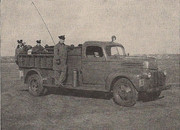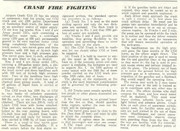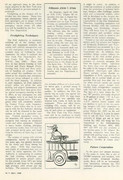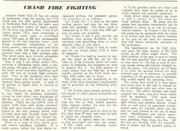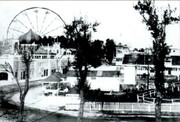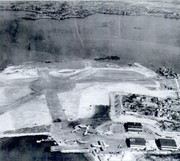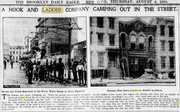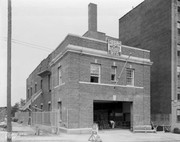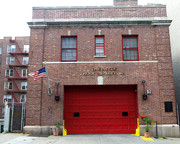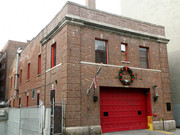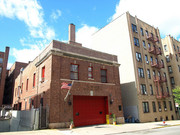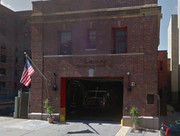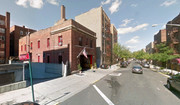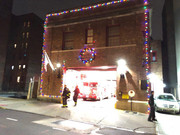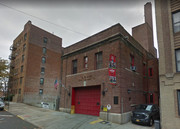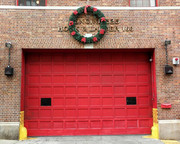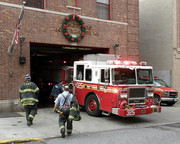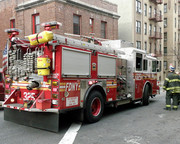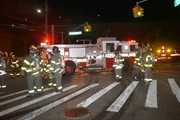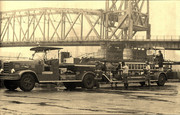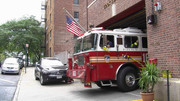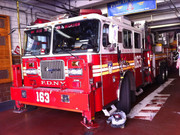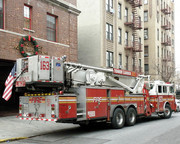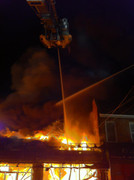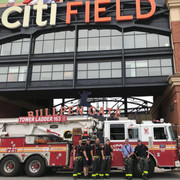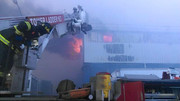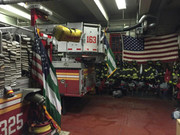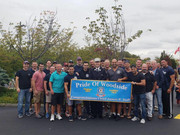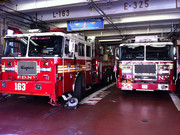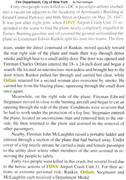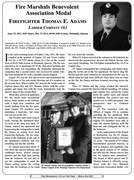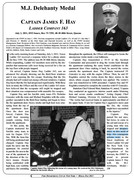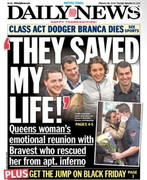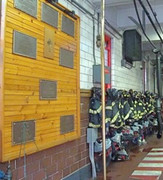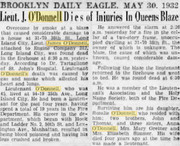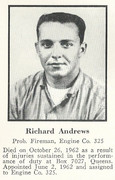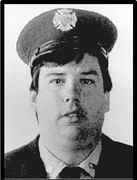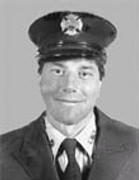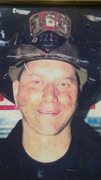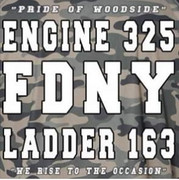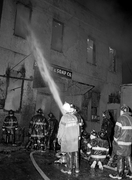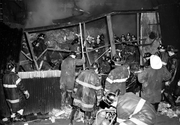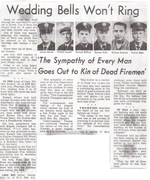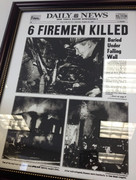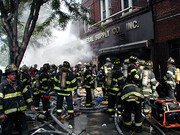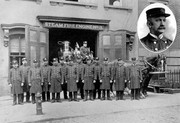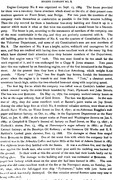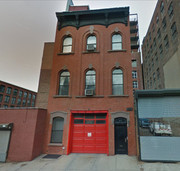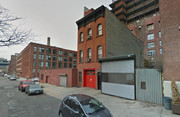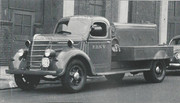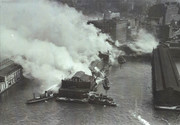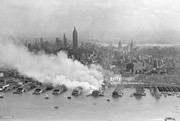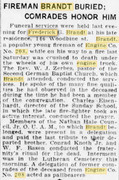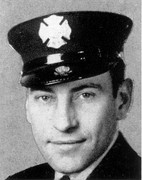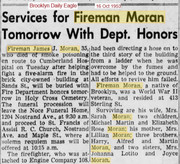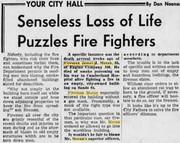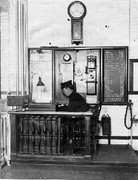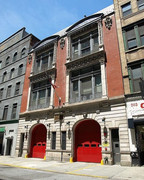Engine 203 firehouse 533 Hicks Street Carroll Gardens, Brooklyn Division 10, Battalion 32
DISBANDED
Engine 3 BFD organized 533 Hicks Street former firehouse volunteer Neptune Engine 2 1869
Engine 3 BFD became Engine 3 FDNY 1898
Engine 3 became Engine 103 1899
Engine 103 moved 274 Hicks Street at Engine 124 1912
Engine 103 became Engine 203 1913
Engine 203 new firehouse 533 Hicks Street 1913
Engine 203 disbanded 1974
District Chief 1 BFD located at 533 Hicks Street at Engine 3 BFD 1896-1898
District Chief 1 BFD became Battalion 2 FDNY at 533 Hicks Street at Engine 3 FDNY 1898
Battalion 2 became Battalion 22 at 533 Hicks Street at Engine 3 1898
Battalion 22 disbanded 1906
Battalion 32 located at 533 Hicks Street at Engine 203 1906-1912, 1922-1940, 1944-1974
Engine 3 BFD at old 533 Hicks Street firehouse 1870s:
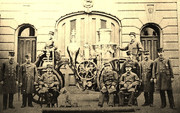
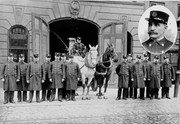
ENGINE COMPANY NO. 3 BFD:
Engine Company No. 3 also began its existence on Sept. 15, 1869. It occupies a Three-story brick building with brownstone front on Hicks Street, near Degraw which in the days of the Volunteer Department was the quarters of Neptune Engine No. 2. The figure of a "rooster " and the words " Neptune No. 2 " carved in the keystone over the doors are still plainly visible to the passer-by. The first floor of the building as in all other engine-houses, is taken up by the apparatus and horses. On the second floor are the sleeping apartments of the men, and the third floor is fitted up as a gymnasium.
The company is equipped with a second-class Amoskeag engine, a hose-cart of the old two-wheel style, and three of the finest horses in the Department; -Paddy," a large handsome iron gray horse, is used on the hose-cart, and "Sam." a glossy black, and Pete, a gray, draw the engine. These fine young animals are the best groomed and
fleetest-footed in the service. Chief NEVIN's horse, "Jim," a beautiful chestnut sorrel occupies one of the stalls. There are, also, three finely bred dogs, whose superior intelligence entities them to favorable mention in the history of this company. " Bob" a thoroughbred Gordon setter is the exclusive property of chief NEVINs. and "Frank" and "Nell", both English coach-dogs with long pedigrees, are the especial pets of every man in the company. "Nell" is noted for her high-jumping qualities, and her agility in hand-ball playing. She can easily bring down a piece of sugar from the top of an eight-foot fence, and can catch a ball in her mouth as well as the average boy can with his hands. The company is one of the best disciplined in the Department, and every man in it is a worker.
They have one of the largest and most important districts in the city to cover and one in which many disastrous fires have occurred. Joralemon Street is the northern boundary; Third Avenue and Twenty-first Street the eastern; Gowanus Bay the southern; and the East River the western boundary. On a first-alarm they respond to calls from eighty-seven boxes, and sixty-five additional on a second-alarm Among the most important buildings in the district are the Harbeck, Pierrepont, Watson, Martin, Columbia, Mediterranean, Dows, Robinson, Baltic and Anchor Line stores which form a continuous chain along the river front south of the Fulton Ferry slips; the India Wharf Brewery, Marks & Rowell's glycerine works. United States Warehousing Company stores, Atlantic Dock Company stores, Dow's, Pinto' s and Lambeer's large grain elevators. Hydraulic Works, Richardson & Boynton's stove works. Pioneer Iron Foundry. Lidgerwood Manufacturing Company, German American stores. New York Warehousing Company, Beard's stores and elevators, Boston Dry Dock Company, J. K Bricks fire-brick yards, Burtiss' ship-yard, Cheeseboro Manufacturing Company, Casey's rosin works, Taylor's saleratus works, Reilly & Crowley's foundry, Williams- Drop Forging Works, Gill's machine shops. Smith & Gray's storage house at foot Hamilton Avenue, Downing & Lawrence ship-yard, POILLON's ship and lumber yards. New York Mica Roofing Works, Bowne's storage and grain elevator, Clombach's boiler shops, Creamer's brass foundry, Hodge's sale stables, Brooklyn City Railroad stables. Swan & Finch's oil works. Nelson Brothers' wood yard, Haggerty's glass works. Roebuck's Planing and Moulding Mills, South Brooklyn Saw Milling Company, John ROGAN & Sons' storage house. Bay State shoe and leather factory, Newmada kid works, New York Color Works, Hobby & Dudy's lumber yard, Fitzsimmon's bird gravel works, Weber & Quinn's coal elevators. Bush's saltpetre works, Buchanan & Lyle's Planet Mills and tobacco factory. New York Tile Works, New York Cream Tartar Works, Gray's Sulphur Mills. Still's Sulphur Mills, Gregory's oil works, Roger's Planing Mills, New York packing box factory, Dykman's packing box factory, Loomis Planing Mills, Kenyon & Newton's sash and blind factory, Watson & Pettinger's lumber sheds, Sylvester & Ross' lumber yard, Hughes' lumber and lime yards, the works of the Citizens' Gas Light Company, Bergen's feed storehouse, Whipple's sash and blind factory, Witte's Weiss beer brewery, Shinnick's pipe works, McCaldin's lumber yard, Jansen & Hamlin Naval Storage Warehouse, the Anglo-American stores, Stein's Sale and Livery Stables, the stables of Wescott's Express Company, O'Brien's dry goods and storage house, Latimer's storage house. Good Care Storage Company, W. H. Mere's wall-paper factory, "Herman Behr's sand-paper factory, F. 0. Pierce's paint works. New York ink works, Brooklyn Button Works, Forsyth Chair Manufactory, Sperry's church furniture and cushion factory, Columbia Chemical Works, Higgins' soap works. New York Oil Pressing Company, Brooklyn Stained Glass Works, Gleason & Howland's coal yard, Casey's wood yards, Klein's coal yards, and the Union Ferry Company repair yards. Among the large flat-houses in the district is the Fougera, the Home and Tower flats at Baltic and Hicks Streets, the Columbia on Union Street, the St. Charles on Sackett Street, and a row of flat-houses on the same street, the Tower flats at Sedgwick and Van Brunt Streets, the Waldo and St. Ann's on Hamilton Avenue, and the Windermere on First Place.
Included also in this territory are the Long Island College Hospital, St. Peter's Hospital, St. Joseph's Home, Public School No. 78 on Pacific Street, No. 13 on Degraw Street, and a branch of that school on Union Street, No. 29 on Amity Street, No. 27 on Nelson Street, No. 30 on Walcott Street, No. 31 on Hoyt Street, and a branch on Degraw Street, St. Paul's Roman Catholic church and school, St. Charles Roman Catholic church and school, St. Peter's Roman Catholic church and school, St. Mary's "Star of the Sea" church and school, St. Bernard's church and school, St. Stephen's church and school. Church of the Visitation and school, and St. Agnes church and seminary for young ladies.
Among other edifices are the Baptist Tabernacle, the Italian and German Catholic churches, Pilgrims' Chapel, South Congregational. Church of Our Saviour (Norwegian) St. Matthew's Lutheran, St. Paul's Lutheran Trinity Lutheran, Carroll Park Methodist Episcopal, First Place Methodist Episcopal, St. Paul's Methodist Episcopal, Warren Methodist Episcopal, St. Ann's Protestant Episcopal churches, St. Margaret's Protestant Episcopal Chapel, St. Paul's Protestant Episcopal church. Strong Place Baptist and the Tompkins Place Episcopal church. There are men in the company who have been to all the big fires since the Department was organized.
The horrible scenes enacted at the burning of the Brooklyn Theatre are vividly impressed on the minds of these men. for they were among the faithful, untiring number who worked for days among the ruins to recover the bodies of the victims of that disaster. Nearly every man in the company has some reason for recollecting the fires which have occurred at Arbuckle's Coffee Mills. Pierrepont stores, Harbeck stores. Standard Oil Works. Richardson's Car Stables, Palmer's Cooperage Havemeyer's Sugar Refinery, Denslow & Bush's oil works, Ridgewood Ice Company's stables, the
Paint and Starch Works fire at the foot of Sixth Street, the Columbia Heights flats, the Glass House on State Street at which several of the men were nearly suffocated by smoke or killed by the falling walls, the Planet Mills fire, the Boston Dry Dock, SHAW's grain stores, and the burning of the ship Pythomone, loaded with jute butts, at Pierrepont stores.
PETER FAGAN was the first Foreman of Engine Company No. 3. He was succeeded by Samuel Duff, who in turn was succeeded by John Duly. Subsequently Charles D. RUDDY was put in command of the company, where he remained up to March 12, 1892, when he was sent at his own request to take command of the new company No. 31 in East New York.
Foreman EDWARD F. CONROY. his successor, has found a warm spot in the hearts of the men who make up a company which has no superiors in the Department as a "working " body. Mr. Conroy was born in Brooklyn. Nov. 7. 1858. He became a fireman, April 22, 1878, and first saw active duty with Engine Company No. 8. From this company he was transferred to Engine No. 5, and later to Engine No. 6. While in this company, on June 29, 1889, he was promoted to the grade of Assistant Foreman. He was advanced to the grade of Foreman, on March 13,1892, and placed in his present command.
Assistant Foreman MICHAEL F. JUDGE was born in Brooklyn, Nov. 18, 1861. He was a truck driver when he was made a fireman, June 15, 1887. He was assigned to duty with Engine N0.4. and remained with the company until June i. 1891, when he was promoted to Assistant Foreman and transferred to Engine No. 3.
Engineer ROBERT REARDON was born in New York City, in 1857. He is a widower And lives at No. 62 Waverly Avenue. He was appointed a fireman, June 1, 1883, and has done duty since that time with Engines Nos. 7, 10, 24 and 3.
MICHAEL F. ROGAN, the driver, was born in Ireland, May 6, 1857. He is married and lives at No. 497 Hamilton Avenue. He was made a fireman, April 4,1885, and saw active service with Engines Nos. 4, 5 and 24, before he became the driver of this company. Mr. ROGAN was a member of No. 4, when the glass house on State Street was burned, May 5, 1885. When the walls fell he had both ankles sprained and his body badly bruised, and was laid up for a long time thereafter.
GEORGE L. MOLLOY was born in Brooklyn, Aug. 17, 1861, and his career as a fireman began June 15, 1885, when he was assigned to duty with this company. When the paint works on Gowanus Canal were burned, in July, 1890, he stood at his post until his left leg was so severely burned, that it was at first believed amputation would be necessary to save his life. It was several months before he was able to return to duty. In January, 1892, he assisted in the rescue of two children from the third floor of a burning building in First Place near Smith Street.
JOSEPH C. RUSSELL was born in Brooklyn, Dec. 23,1858. He resides with his family at No. 595 Clinton Street. He was made a fireman Dec. 15, 1885, and has been attached to Engines Nos. 2,4 and 3. In Feb., 1892, Engine No. 3 was first at the scene of a fire on Warren Street, caused by a lamp explosion, and Russell dashed up the stairway, burst in the door, wrapped his coat about a German woman whose clothes were set on fire by the explosion, and carried her out. She was so badly burned that she died later at St. Peter's hospital. In Sept. 1890 while carrying a hose at midnight into the hold of a burning ship lying at the North Central Pier, Atlantic Basin, he fell through an open hatch, forty feet into the hold, but fortunately struck on a pile of coffee bags, and escaped without having any bones broken. On Dec. 29, 1891, at a fire in the Amalga Soap Works, at Nos. 85 and 87 Sedgwick Street, he fell two stories through a hatchway and dislocated one of his shoulders.
JAMES LAWLER is an " old-timer" and has been an active worker at all the great fires since he was appointed to the force, April 28, 1870. He was a member of this company when the Brooklyn Theatre burned, and assisted in taking out the bodies of many who perished in that fire. He was born in Ireland, July 21, 1845, is married and lives at No. 140 Van Brunt Street. He is detailed as an operator at the fire telegraph office in Jay Street.
JAMES MCCARTHY was born in New York City, May 20,1848. He resides at No. 505 Hicks Street, and was made a fireman Nov. 20, 1870. In 1880 while with Engine Company No. 4, he with fireman John MULLALY of that company, rescued a man, his wife and three children from the second story of a dwelling on Atlantic Avenue, near Court Street. At a fire on Second Street, in the winter of 1880 -'8l, he with Mr. DOOLEY, now Foreman of Engine No. 26, saved the lives of two women, who lived on the third floor and had been overcome with smoke. He was present and assisted in taking out the bodies of the victims of the Brooklyn Theatre fire.
MICHAEL HART was born in Brooklyn, Dec. 19.1861. He became a member of the Paid Department, March 1, 1884 and was assigned to Engine Company No. 5. He is married and lives at No. 459 Sackett Street.
THOMAS F. BURNS is a native of Brooklyn, born March 17,1865. He lives with his family at No. 194 Hicks Street, and has been connected with this company since the date of his appointment, Aug. 1, 1889. At the Smith & Gray fire. Feb. 28, 1892 he fell from the roof of a building on Grove Place and received severe injuries to his back and shoulders.
JOHN H. GORDON was born in this city Sept. 15, 1853, and since he became a fireman, on March 20, 1888, has been doing duty with this company. He is married and lives at No. 106 Baltic Street.
JOHN W. FARRELL first saw the light on May 29, 1852, in New York City. His career as a fireman began Dec. 15. 1885 as a member of Engine Company No 3 While coming down the pole in the engine-house to respond to an alarm of
fire on the night of March 5, 1890, he fell and broke his right ankle, and was laid up for four months. In January 1892, he assisted Fireman MOLLOY in rescuing two children from a dwelling-house fire on First Place, near Smith Street.
PATRICK HARRIGAN is a native of Ireland, and was born in Jan., 1868. He is a bachelor and lives at No. 76 Mill Street. He has been attached to this company since he was made a fireman, Aug. 11, 1891. 533 Hicks Street firehouse:
(from Our Firemen the Official History of the Brooklyn Fire Department)
533 Hicks Street:
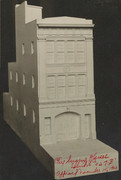
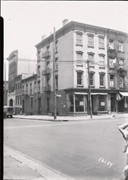
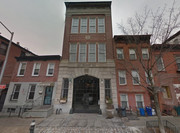
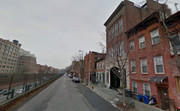

Engine 203:
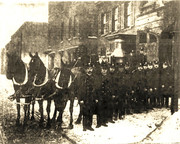
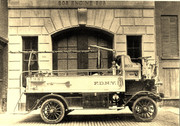

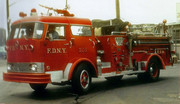
Engine 203 history:
Mascots - "Chief" 1929-1939 - responded with company - received 4 medals
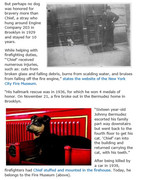
http://hatchingcatnyc.com/2017/10/28/fire-dog-brooklyn-engine-203/
1936 multiple alarm - E 203 members and mascot:
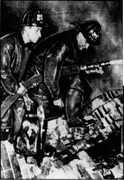
Neighborhood coal distribution station during World War II coal shortage:
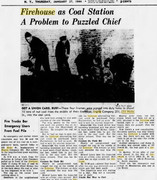
Engine 203 buried - 15 members trapped - warehouse collapse - January 15, 1954:
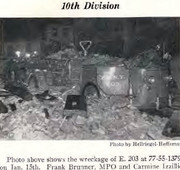

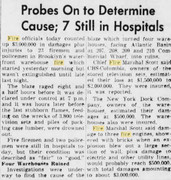
Engine 203/Battalion 32 medals:
EDWARD F. NEALIS FF. ENG. 203 SEP. 8, 1902 1903 BROOKLYN CITIZENS

CHRISTOPHER H. MC GANN FF. ENG. 203 DEC. 18, 1918 1919 CRIMMINS

MARTIN J. MC NAMARA FF. ENG. 203 AUG. 31, 1924 1925 PRENTICE
JOSEPH IKENSON FF. ENG. 203 JUN. 13, 1946 1947 DEPARTMENT
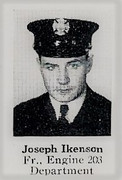
PATRICK HICKEY BAT. CHIEF BAT. 32 OCT. 2, 1939 1940 HUGH BONNER
The Hugh Bonner Medal was awarded to Battalion Chief Patrick Hickey of the 32nd Battalion, for participating in the rescue of two fireman from a fire at 366-70 Hamilton Avenue on October 2, 1939. Members of Engine 279 were operating a hose line in the cellar of this building until their position became untenable. Battalion Chief Hickey was with the company at the time and ordered them to withdraw. When they reached the street, he learned that two of the men were missing. He ordered Fireman William C. Dunne of Engine 279 to accompany him back into the cellar to find the missing men. In the face of intense heat, smoke and gas they searched the cellar. Fortunately they found Fireman 3rd grade and Ununiformed Fireman Joseph E. Cordes, both of Engine 279, lying unconscious in about twelve inches of water. They succeeded in carrying the unconscious men up the stairway to the street and safety. Fireman William C. Dunne received the Brooklyn Citizens? and a Department Medal for his part of the rescue.
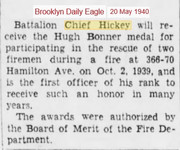
Engine 203/Battalion 32 LODDs:
FF James W. McCosker, Engine 203, Brooklyn box 44-728, 3rd Street Pilgrim Laundry, November 4, 1906
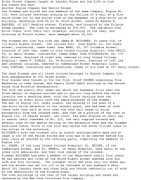
FF William F. Stanton, Engine 203, pinned by hose tender during skid responding, October 23, 1912
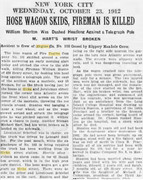
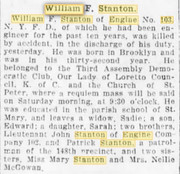
BC Anthony Jireck, Battalion 32, overcome by smoke, January 27, 1945


Medal as Probationary FF:

FF Michael J. Berkery, Engine 203, Brooklyn box 44-508, Pier 29, Buttermilk Channel, foot of Kane Street, drown in hull of SS Congo
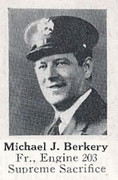


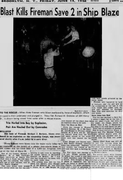
Never forget.
Pre-BFD former volunteer company - Neptune Engine 2 - 533 Hicks Street:


Carroll Gardens:
http://www.bklynlibrary.org/ourbrooklyn/carrollgardens/
Brooklyn Queens Expressway:
http://www.nycgovparks.org/about/history/historical-signs/listings?id=11721
http://www.nytimes.com/2012/01/05/nyregion/on-the-bqe-road-work-ahead-forever.html?_r=0





